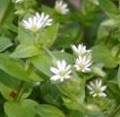 Common chickweed is a cool-season annual native to Europe but is found throughout North America. It prefers moist fertile soil in sun or partial shade and is common in disturbed soil such as garden beds and new lawns as well croplands of small winter grains where it can cause considerable loss. Common chickweed can be a reservoir for insect pests, tomato spotted wilt virus, and cucumber mosaic virus. Common chickweed is edible; chickens and other birds often eat the seeds, giving rise to the common name, while humans find the taste of the leaves agreeable and similar to spinach.
Common chickweed is a cool-season annual native to Europe but is found throughout North America. It prefers moist fertile soil in sun or partial shade and is common in disturbed soil such as garden beds and new lawns as well croplands of small winter grains where it can cause considerable loss. Common chickweed can be a reservoir for insect pests, tomato spotted wilt virus, and cucumber mosaic virus. Common chickweed is edible; chickens and other birds often eat the seeds, giving rise to the common name, while humans find the taste of the leaves agreeable and similar to spinach.
 Description: Cool weather favors the germination and growth of common chickweed so it is most commonly seen from fall through spring. It is very cold hardy and will even sprout and grow during warm spells in winter. Plants grow very quickly into a large mat covering the ground. The prostrate stems bear rows of tiny hairs, are freely branched, and root at the nodes. They grow 4-12” long and their tips tend to grow upward especially in warm weather. The opposite, light green leaves are oval or elliptical, and ½” to 1¼” in length. The lower leaves have petioles while the upper ones do not. Small white flowers appear singly or in clusters beginning in late winter or early spring with five petals that are so deeply divided that they give the appearance of ten petals. Flowering continues until warm weather arrives. The fruit is a one-celled capsule containing a large number of seeds so that a single plant can produce up to 15,000 seeds that remain viable in the soil for up to ten years. The root system is fibrous and shallow.
Description: Cool weather favors the germination and growth of common chickweed so it is most commonly seen from fall through spring. It is very cold hardy and will even sprout and grow during warm spells in winter. Plants grow very quickly into a large mat covering the ground. The prostrate stems bear rows of tiny hairs, are freely branched, and root at the nodes. They grow 4-12” long and their tips tend to grow upward especially in warm weather. The opposite, light green leaves are oval or elliptical, and ½” to 1¼” in length. The lower leaves have petioles while the upper ones do not. Small white flowers appear singly or in clusters beginning in late winter or early spring with five petals that are so deeply divided that they give the appearance of ten petals. Flowering continues until warm weather arrives. The fruit is a one-celled capsule containing a large number of seeds so that a single plant can produce up to 15,000 seeds that remain viable in the soil for up to ten years. The root system is fibrous and shallow.

 Control: The prolific seed production over a long period of time plus the long viability of the seeds makes this weed difficult to control. Removing the flowers before they set seed is essential and can be done by mowing where infestations are large but keep in mind that plants can flower and set seed at the same time and the seeds do not need a ripening period so constant vigilance is required. Hand pulling and hoeing are effective if care is taken to remove the crown and to dispose of all stems so that they will not root. Mulch is effective in preventing seeds from sprouting. In extreme cases, preemergent and postemergent herbicides can be used.
Control: The prolific seed production over a long period of time plus the long viability of the seeds makes this weed difficult to control. Removing the flowers before they set seed is essential and can be done by mowing where infestations are large but keep in mind that plants can flower and set seed at the same time and the seeds do not need a ripening period so constant vigilance is required. Hand pulling and hoeing are effective if care is taken to remove the crown and to dispose of all stems so that they will not root. Mulch is effective in preventing seeds from sprouting. In extreme cases, preemergent and postemergent herbicides can be used.